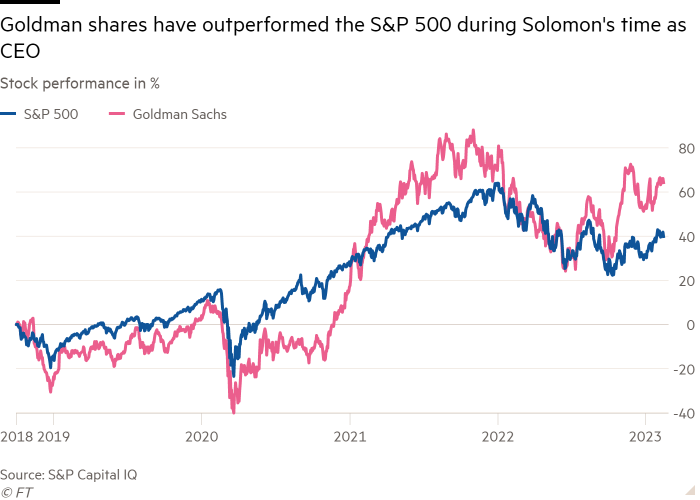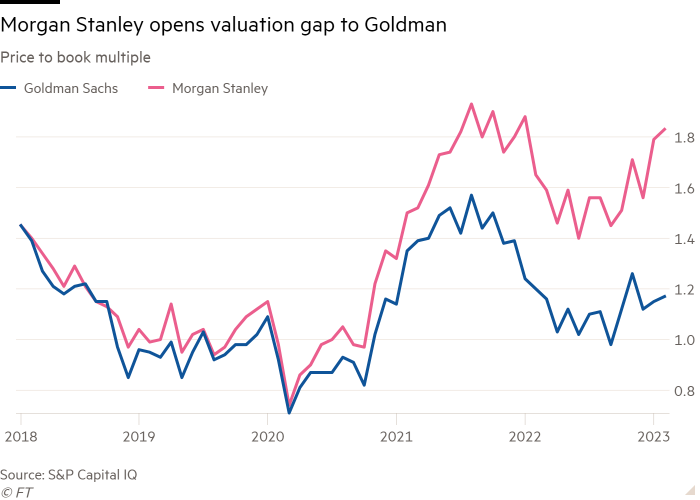Earlier this month, in front of massed rows of Goldman Sachs partners at a controversial private meeting in Miami, chief executive David Solomon performed a rare mea culpa.
The four-day off-site event, which also featured a fireside chat with comedian Trevor Noah, was Solomon’s chance to explain the deep bonus reductions and job cuts that he said he had been forced to implement as the economy turned. Solomon’s acceptance of his mistakes was welcomed by some of the angry partners in attendance, said people briefed on the event.
The Goldman boss will hope to be as convincing later this month when he faces shareholders at the bank’s second-ever investor day at its 200 West Street headquarters in downtown Manhattan.
Solomon will be trying to reassure them that he can get staff back onside and that a painful fall in profits in the fourth quarter does not mean Goldman is moving in the wrong direction.
Rasmus Lee Hansen, portfolio manager at AllianceBernstein, a top-20 shareholder in Goldman, said he wanted to hear “a humble presentation” from Solomon that acknowledged mistakes that have been made, including an expensive bet on consumer banking.
“Now the right choice is to scale back on [the consumer bet] and continue with the ‘old Goldman’” focused on trading, investment banking and dealmaking, Hansen said. “I think they would get points for that.”
Goldman said it was “looking forward to investor day” and the chance to “help investors see the strategic direction going forward”.

Since Solomon took over as chief executive in 2018, Goldman has expanded its market share in its core investment banking and trading business but efforts to diversify the bank’s revenues into newer, less volatile areas, have been less successful.
“It’s a lukewarm grade for strategic transformation so far. In essence, Goldman is essentially what it was five years ago,” said Christian Bolu, a senior research analyst at Autonomous Research.
Goldman’s stagnant revenue mix has meant that, although its share price has outpaced the benchmark S&P 500 index under Solomon as its profits have grown, the company’s price-to-book ratio, which compares a bank’s stock price against the value of its assets, is largely unchanged.
Investment banking and trading, while highly lucrative in good years, are less cherished by stock market investors because their performance is unpredictable. Longtime Wall Street rival Morgan Stanley has been able to improve its stock market valuation and opened a gap on Goldman in recent years by growing in asset and wealth management, activities that promise more stable returns.
The fourth quarter typified that gap as plunging investment banking fees hurt both banks but Morgan Stanley could lean on record wealth management revenues to prop up results.

Solomon does have some cards to play when trying to demonstrate progress at investor day: he can champion the market share gains in Goldman’s legacy businesses as well as $179bn of inflows since the end of 2019 for its asset management business, which generate the kind of steady management fees prized by investors.
However, the asset management business is still dominated by Goldman’s so-called on-balance sheet investments, a remnant of the era when the bank would wager its own capital. That business can generate enormous profits in good years but can also inflict pain, such as a $660mn loss in the fourth quarter.
Goldman is in the process of trying to shrink these investments so the majority of revenues in asset management come from fees from third-party funds.
The biggest black mark on Solomon’s efforts to transform Goldman was his expansion of the consumer banking business, a project that started under predecessor Lloyd Blankfein with the Marcus savings account but ballooned under the new chief executive.
Solomon said in October that Goldman was paring back its consumer effort in response to shareholder unease about its swelling losses. Part of that business has been repacked into a new financial technology division named “Platform Solutions”, which suffered $2bn in losses last year.
Investors are expecting more complete explanations of why these decisions were taken and where they go from here at investor day.
“The question for Goldman was: ‘What do you want to expand?’ They took it into new businesses, which I see as almost research and development projects. If they’re good, great. If not, you pull back,” said another top-20 investor.
“I give [Solomon] credit for trying a new direction . . . Frankly, I would be more critical if he hadn’t tried anything new,” the investor added.
Crucially, Solomon will again have to address signs of unhappiness inside the bank, typified by a raft of senior departures including chief financial officer Stephen Scherr, co-head of investment banking Gregg Lemkau and co-head of asset management division Eric Lane.
“Anytime people are upset, it’s relevant. You would hope he hears his employees,” said a third top-20 Goldman investor.
More than a third of the 26 speakers at Goldman’s first-ever investor day three years ago have now left the bank. And although Solomon’s contrition in Miami smoothed some ruffled feathers, other bankers remain angered by the event itself.
Employees saw it as clashing with the job cuts and the push for savings, which includes banning travel unless it is approved by one of the bank’s partners, according to people familiar with the policies. Goldman said it wanted “partners to go out and meet aggressively with their clients this year”.
Goldman executives have also argued that having the bank’s top employees gather in Miami allowed them to focus on the bank’s strategy. That included, they said, going over slides for the investor day presentations.
Amid the growing anger, Solomon made a rare visit in late January to Goldman’s trading floor in New York — a clear sign, say insiders, that he is trying to rally support.
Solomon was seen meeting with Ashok Varadhan, co-head of Goldman’s global banking and markets division, as well as telling the rates desk what a good job they were doing, according to people familiar with the visit.
It was the first time many employees could remember that Solomon, a career investment banker, had visited the trading floor since becoming chief executive. Blankfein, who made his name at Goldman in the markets business, was known to visit the trading floor regularly.
“David is extremely accessible and is in the building and always available,” said Goldman.
Solomon has also tried to make himself a more accessible chief executive for shareholders. This has included basic gestures such as speaking to analysts on earnings calls — something Blankfein had delegated to his chief financial officer — and hosting that first-ever investor day in 2020.
But three years on from that showpiece event, Solomon remains under pressure.
“As much as the last investor day was about their vision of building a broader and diversified and more durable Goldman Sachs and showed off some its new toys, this investor day is going to be them saying clearly that we’re going to be a much more profitable and consistent Goldman Sachs,” said Glenn Schorr, senior research analyst at Evercore.



